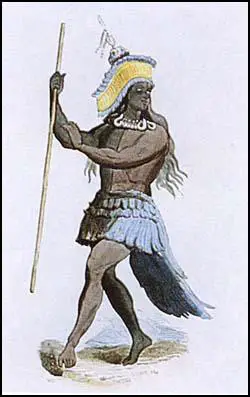Costanoans
The Costanoan people, also known as the Ohlones, are a Native American people who lived between San Francisco and Big Sur, on the Pacific Coast. The name Costanoan comes from a Spanish word meaning the "people of the coast". According to Tom Cole, the author of A Short History of San Francisco (1981), the Costanoans "were part of the Pleistocene Epoch migration of Asian peoples across the land bridge that is now the Bering Strait."
Kevin Starr, the author of California (2005) has argued that the Miwok and the Costanoan were the two main tribes in the San Francisco Bay area. He adds that the archaeological evidence suggests that they were "shell-fish gathering people, and over the centuries they left behind great mounds of shells from innumerable feasts". Nels Christian Nelson, did a study of the bones found in these mounds and in his book, Shellmounds of the San Francisco Bay Region (1909), argues that these people hunted deer, elks, sea otters, beavers, badgers, squirrels, rabbits, wildcats, dogs, seals, ducks and geese.
Jean-François de Galaup de la Pérouse was one of the first to record the behaviour of the Costanoans. He recorded in September, 1786, when he was in Monterey: "These Indians are very skilful with the bow; they killed some tiny birds in our presence; it must be said that their patience as they creep towards them is hard to describe; they hide and, so to speak, snake up to the game, releasing the arrow from a mere 15 paces. Their skill with large game is even more impressive; we all of us saw an Indian with a deer's head tied over his own, crawling on all fours, pretending to eat grass, and carrying out this pantomime in such a way that our hunters would have shot him from 30 paces if they had not been forewarned. In this way they go up to deer herds within very close range and kill them with their arrows."

The early Spanish explorers were shocked that the Costanoans were willing to eat insects, animal entrails and all kinds of seeds and roots. After seeing them digging for food they were given the name "diggers". It was later that the Spanish gave them the more respectiable name, Costanoans.
According to the authors of The Natural World of the California Indians (1980), the Costanoans, along with the Yokut and the Gabrielino, tobacco played an important role in tribal life: "Tobacco was mixed with lime from seashells and eaten. A kind of intoxication resulted, though the main effect seems to have been vomiting."
Robert F. Heizer has argued that the Costanoans, like other Californian tribes such as the Maidu, Miwok and Yokut, were members of the Kuksu cult: "The cult ceremonies, performed by spectacularly costumed dancers, were held in the spacious, earth-covered roundhouses which represent the largest and most complex architectural achievement of California Indians. The basic purpose of the Kuksu cult appears to have been to renew the world each year and guarantee the continuance of the natural foods (animals and plants) that supported men."

Francisco by Louis Choris (1816)
The Mission San Francisco de Asís was established by Francisco Palóu, a student of Junipero Serra, in San Francisco on 29th June, 1776. It was built close to the the Costanoan village of Chutchui. Attempts were made to convert them to Christianity. According to Tracy Salcedo-Chouree, the author of California's Missions and Presidios (2005): "The padres would harvest for souls and laborers with questionable success. Indians from the more distant rancherias of the Coast Miwok, the Wappo, the Patwin, and the Yokut would find themselves living at one time or another at the mission, where they would work at becoming good Christians as well as good builders, farmers, weavers, and tanners, and, from many accounts, long to return to their native homes and lifestyles. They would also find themselves plagued by whippings, hunger, and disease.... But eventually some Indians did convert, swelling the mission's population to nearly 1,000 by 1794. Runaways and disease kept the numbers in check, however: A measles epidemic struck in 1795, killing a large number of neophytes, and more than 200 fled mission in its aftermath." Mission records show that by 1842 only 37 Native Americans were left in the settlement."
Alfred L. Kroeber estimated in The Handbook of the Indians of California (1919) that the Costanoan population was about 7,000 before the arrival of the Spanish. Later researchers such as Richard Levy, claim that the true figure was over 10,000. However, Sherburne F. Cook argues that it could have been as high as 26,000. In his book, The Population of the California Indians, 1769-1970 (1976), Cook suggests that by 1848 the population was only about 2,600. He added: "Not until the population figures are examined does the extent of the havoc become evident."
